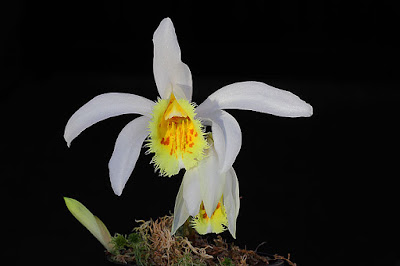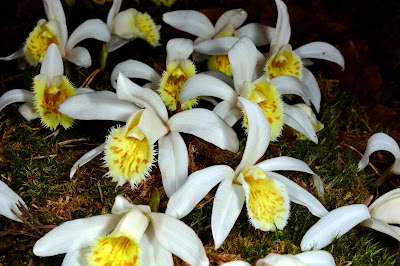Pleione grandiflora is found in southern Yunnan, China and Vietnam. It grows on mossy cliffs and boulders in forests at elevations of 2600-2900 meters.
Pleione grandiflora also called as The Large Flowered Pleione, Coelogyne grandiflora, Pleione barbarae, Pleione harberdii, Pleione moelleri, Pleione mohrii, Pleione pinkepankii, is a species of the genus Pleione. This species was described by Robert Allen Rolfe in 1903.
IDENTIFY PLEIONE GRANDIFLORA ORCHID PLANT
Pleione grandiflora is found in southern Yunnan, China and Vietnam. It grows on mossy cliffs and boulders in primary highland cloud forests at elevations of 2600-2900 meters.
It is a miniature to small sized, cool to cold growing terrestrial and lithophyte with an elongate, 3-4.5 x 1.2-1.5 cm pseudobulb carrying a single apical, plicate, thin leaf.
The Large Flowered Pleione blooms as a new growth arises in the spring on a 7.5 cm long, single flowered inflorescence carrying a fragrant flower. The flowers are large, white, sometimes with dark purplish red or brown spots and streaks on lip. Dorsal sepal oblanceolate, apex rounded; lateral sepals narrowly elliptic, slightly oblique, usually slightly shorter but wider than dorsal sepal, apex obtuse. Petals oblanceolate, falcate, apex rounded; lip broadly ovate-elliptic to flabellate, obscurely 3-lobed, base narrowed into a claw, upper part of lateral margins and apical margin coarsely lacerate, apex emarginate.
PLEIONE GRANDIFLORA ORCHID PLANT CARE AND CULTURE
Cultural information should only be used as a guide, and should be to be adapted to suit you. Your physical location; where you grow your plants, how much time you have to devote to their care, and many other factors, will need to be taken into account. Only then can you decide on the cultural methods that best suit you and your plants.
Light:
Pleione grandiflora needs a light level of 18000-30000 lux. This species prefer about 50%-70% shade and should not be placed in full sun.
Temperature:
The recommended temperature is 25°C in summer and 1-5°C in winter. However they will tolerate higher summer temperatures of 35°C for short periods. They need cool to cold temperatures in winter of between 1 and 5°C.
Humidity:
The Large Flowered Pleione need good air movement. Place them near the bottom of the shade house where it is coolest and humidity highest. Misting is beneficial in very hot weather.
Substrate, growing media and repotting:
Pleione grandiflora grow best in squat pots. This plant require a free draining open potting mix. Small sized bark mixed with perlite in a 3:1 ratio is a suitable mix. Some growers use sphagnum moss instead of perlite but this can become soggy and perlite is considered a better option.
The plant should be repotted when they are dormant in winter. Their roots die at the end of the season. When repotting remove all the roots leaving about 3 cm of roots to anchor the pseudobulb in the compost.
Watering:
This orchid should be watered regularly through the warmer months but totally dry in winter. Water in the early morning and not during the heat of the day. Roots start to grow as the flowers die and only a little water should be given from this time on as they have yet to develop roots. Keeping them drier at the start of the growing season also encourages the roots to penetrate. Over watering during the early root growth stage is a major cause of plant loss. Once leaves are well developed they can be watered freely. Stop watering when the leaves go yellow and allow them to become completely dry.
Fertilizer:
You can use regular but weak liquid fertilizer during their growing period but not when they are dormant. Use a lower Nitrogen fertiliser at the end of summer to encourage flower bud development.
Rest period:
Pleione grandiflora goes to sleep from late autumn to early spring. Watering should be stopped when the leaves begin to fall. Fertilization should be stopped during this period. When new sprouts appears, the rest period end, the amount of water and fertilizer can be back to normal level.















COMMENTS